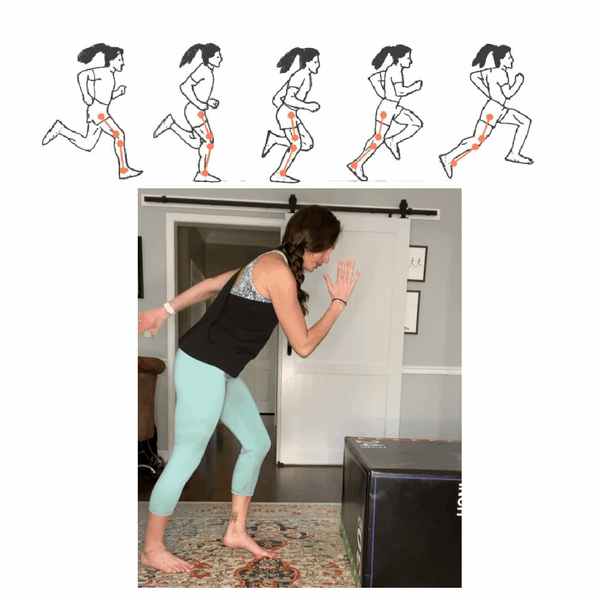
4 Components Every Runner Should Add to Their Home Strength Training Program
Jul 25, 2023If you follow me on Instagram, you may have seen my related post, so you already get the gist of what runners should incorporate into their running. However, I added one more (there were 3 yesterday) after thinking about it further and wanted to expand on it a bit more in general. So here are the 4 components every runner should add to their home strength training programs!
Have you seen the standard 6 movement patterns commonly recommended for strength training for runners?
Push
Pull
Squat
Lunge
Hinge
Carry (or core)
It's a great place to start and a helpful framework for putting together your workouts. I have a cheat sheet based on this same idea. Although, I feel like it could use a bit of an upgrade!
4 Game-Changing Components to Integrate Into That Formula:
1: Emphasis on organizing your center of mass over your stance leg
Mastering mid-stance is a major piece of the puzzle for good running form. We have to be able to fully load through mid-stance so that we can propel ourselves forward. I love this Front Foot Elevated Split Squat to fit into your squat movement pattern and help facilitate organizing your center of mass over your stance leg.
- Weight organized over stance leg.
- Driving pronation at the foot with the knee tracking over the toes.
- Length on the opposite side (I need some work on this on my right!)
- Obliques and adductors "on".
2: Emphasis on rotation & counterrotation
Efficient forward motion in running requires rotation! To be able to move forward efficiently you have to rotate. Your whole pelvis needs to rotate from side to side. For that to happen your femurs (thigh bones) have to rotate in your pelvis and your thorax needs to counter-rotate (rotate the other way) so that you can keep running and looking forward.
This concert of rotation needs to happen so that you can minimize the negative impact of ground reaction forces on your body, while storing some of that energy in your tendons to keep moving forward. Maximum rotation happens a toe-off so that by the time the foot strikes the ground, that side of the pelvis and torso are already rotating back, which reduces the impact on the body.
There are many ways to incorporate rotation into your workouts. My Women’s Running Academy workouts have it sprinkled everywhere! Here’s just one example:
You can use the Dynamic Step Row Reach with Knee Drive to fit into your pull movement pattern and help work that counter-rotation of the torso and pelvis,
3: Co-Contractions
Co-contractions are defined as the contraction of all the muscles around a joint (primarily knee and ankles here) during rapid movement to ensure necessary stiffness and spring actions around a joint.
- They help you "pre-tense" the muscles around your joints to help accept the load as you run - protecting your joints and helping to store elastic energy to keep moving forward.
- They help you practice hip extension before knee extension - a crucial piece to getting power from your toe-off using your glutes.
I include this in some shape or form in all the workouts I program for my runners, especially that pre-run warm-up for track workout days! The Co-Contraction to a Box is one of my favorites in my pre-run warm up! I go over this exercise more in-depth in "How Having the Right Running Warm-up for You, Can Improve Your Life!" blog.
4: Plyometrics for absorbing and rebounding.
Practicing landing, loading, and rebounding can help your body better withstand the forces of running AND use those ground reaction forces more efficiently to propel you forward. I like to sprinkle in some that work on power and quick turn over, some on landing/loading and some that promote that springiness (shown respectively below).
Please don't throw out those 6 movement patterns above; integrate these 4 key components into them! And don’t forget getting stronger altogether goes a long way. It's not just the WHAT but the HOW!
Join me virtually to gain a deeper understanding of the physics and physiology of running and what that means for your body and your training so that you can unlock your full running potential.
The Runner’s Lab is a 2 hour virtual masterclass, part powerpoint style education and part practice to move, feel, and experiment in your body.
Education on your physiology, stress resilience, running biomechanics and my 5 essential skills for an efficient stride so that you understand the “how” your body works together and the "why" behind the exercises and movements in the practice.
Practice with tuning into your physiology and the 5 essential skills so that you can feel and seamlessly apply it to your body and overall training strategy moving forward.
This masterclass is now on demand. You get immediate access upon registration.
Don't miss a thing!
Join my newsletter, be the first to know about what's coming up, and get even more great content!






